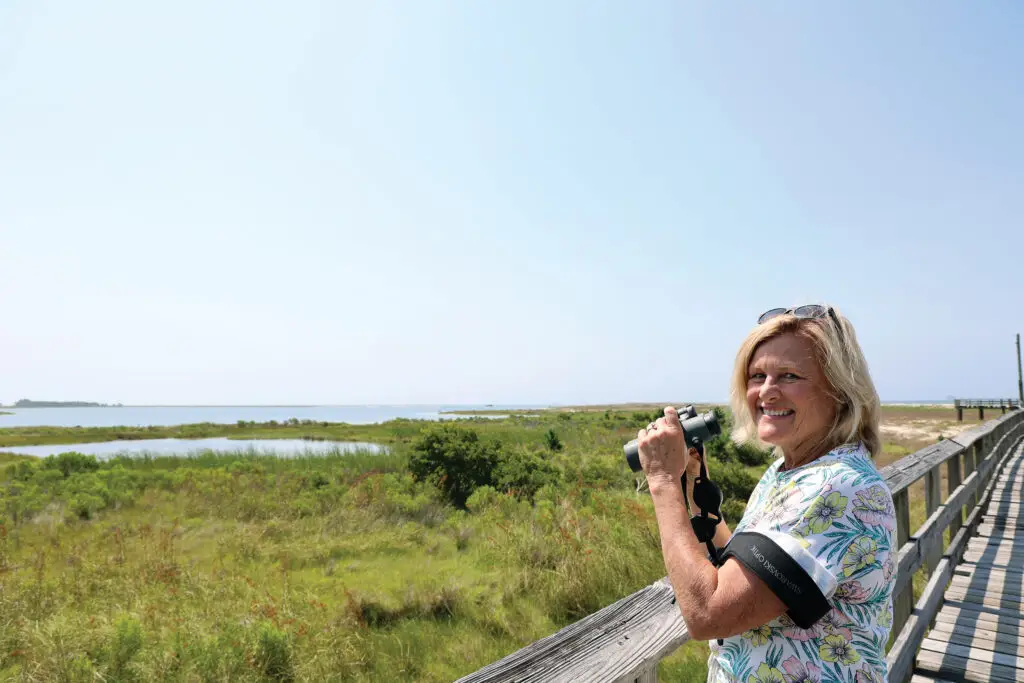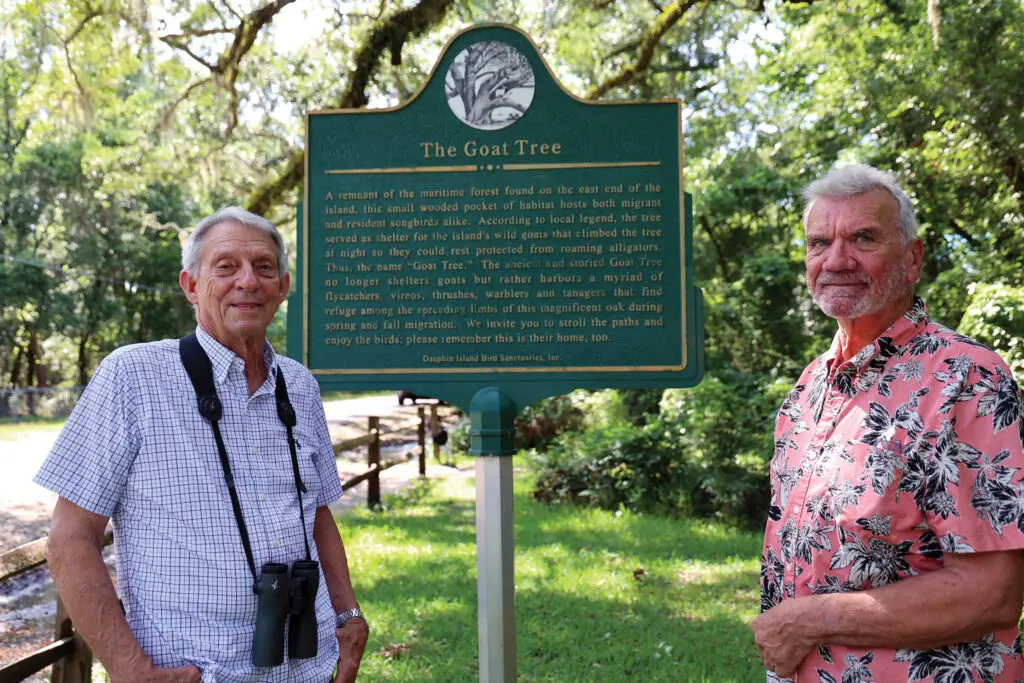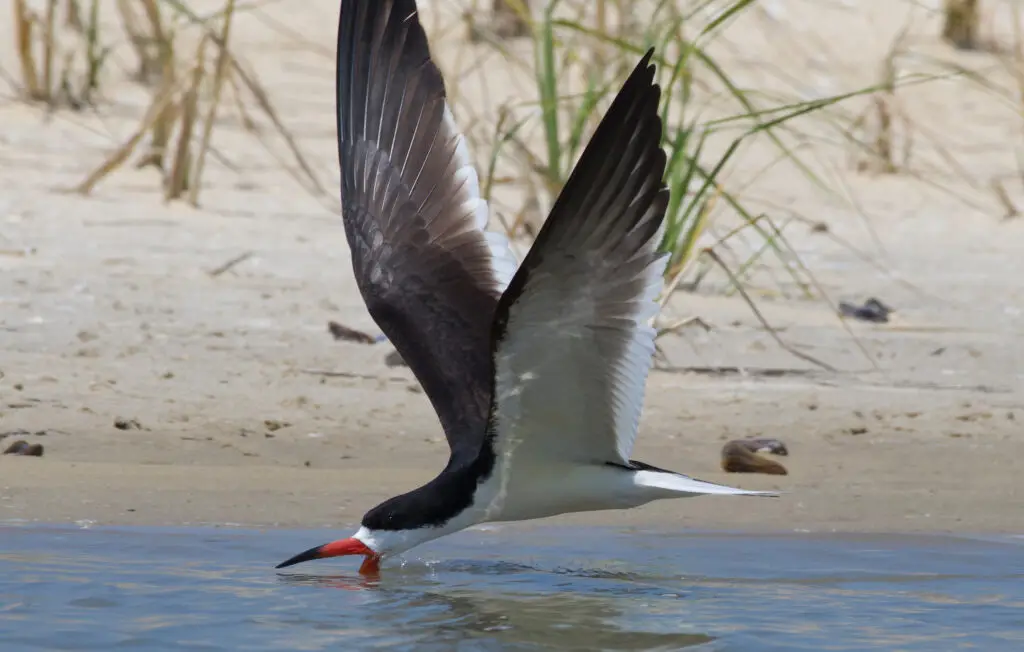Dauphin Island bird sanctuaries protect habitat for birds and people
By Katie Jackson
Imagine an island where birds of all colors, shapes and sizes fill the skies—and the trees and the beaches and the surf. Actually, there’s no need to imagine it, because just such an island exists right off Alabama’s Gulf Coast, and it is a sanctuary for both birds and people.
Dauphin Island, a six-square-mile barrier island 30 miles south of Mobile, is home to some 1,800 permanent residents and thousands of annual visitors who come there to enjoy world-class fishing, pristine beaches, first-rate environmental education opportunities and an almost-extinct old-school beach town charm. It’s also an important part of our state’s entire ecosystem.
“An Alabama without Dauphin Island is unimaginable,” says Dr. Scot Duncan, executive director of Alabama Audubon and author of the award-winning book Southern Wonder: Alabama’s Surprising Biodiversity.

Why is it unimaginable? For lots of reasons.
One of the most biologically diverse barrier islands in the U.S., Dauphin Island provides critical habitat for an array of wildlife species—from dolphins, sea turtles, gamefish and other marine life to reptiles, amphibians and, most famously, birds.
Known as the “Birdiest Small City in America,” the island is one of the top four birding sites in the U.S. and is designated as a “Globally Significant Important Bird Area” by the National Audubon Society.
That’s because the island supports a spectacular array of bird species, from raptors, shore and wading birds, woodpeckers and myriad other year-round and seasonal birds to more than 400 species of migratory neotropical birds that drop by each spring and fall to rest and refuel as they make their biannual 600-mile nonstop flight across the Gulf of Mexico from and to the Yucatan Peninsula.
“They need food and water in both directions and Dauphin Island is the first little place jutting out on the water that they have the opportunity to hit,” says Ralph Havard, a 45-year resident of the island who has long appreciated its natural treasures.
The diversity of birdlife on the island makes it a must-see site for bird and nature lovers from around the world, but it is also a must-have site for the world’s birds, which are facing alarming population declines.

Photo By Cynthia Freeman
According to Andrew Haffenden, an internationally known birding expert who now lives on Dauphin Island, some three billion birds have been lost in North America since 1970 to factors such as habitat loss and degradation, overuse of chemicals and collisions with human-made structures like windows, buildings, powerlines and wind turbines.
“The estimate is that 30 percent (of the world’s total bird population) has disappeared in the last 30 years, and some species are being lost at even higher and faster rates—up to 6 to 10 percent per year,” he says.
Dauphin Island plays a crucial role in the protection and wellbeing of those birds, but also for Alabamians. For example, the island is Alabama’s first line of defense against severe storms and hurricanes coming off the Gulf of Mexico and it also helps buffer the effects of coastal elements such as waves, tides and currents. In addition, it’s one reason Alabama is a biodiversity super star, ranked fourth in overall biodiversity in the nation.
Preserving and protecting
With so many lives depending on the island, protecting Dauphin Island is of paramount importance. But doing so requires a balance between preserving natural habitats and addressing the demands of community growth and development.
The need for that balance has long been recognized on the island, early planners of which set aside several parks and natural areas in the 1950s and `60s. In 1988, when the Town of Dauphin Island was officially incorporated, one of the council’s first acts was to designate the entire island as a bird refuge. Over the years, and with support from various agencies and conservation organizations—the National Fish and Wildlife Foundation, South Alabama Land Trust and the Nature Conservancy, among them—additional areas of vital habitat have also been protected.

But in the 1990s, development threatened the Audubon Bird Sanctuary, a 164-acre area containing a mixture of several critical habitats including maritime forest, marsh and dune ecosystems, which spurred local volunteers to take action.
Those volunteers were members of the Friends of the Dauphin Island Audubon Sanctuary, an ad hoc advisory group of bird and nature lovers who worked with town leaders to monitor, maintain and protect the island’s natural areas. When development efforts began encroaching on the sanctuary, FODIAS members leaped into action and purchased an adjacent lot that helped buffer the area from development while also improving options for parking and access to the sanctuary.
From that initial purchase sprang a new paradigm and a renewed passion for protecting ecologically important sites on the island, an effort spearheaded by the late John Porter, a University of Alabama physics professor who, along with his wife Jackie, birded regularly on Dauphin Island.
After years of people saying, “somebody should” take action to protect the island’s ecosystem, “John Porter was the first one to say, ‘we’ll do it,’” says Betsy Eagar of Mobile, a long-time birder who fell in love with Dauphin Island years ago.
Over time, FODIAS was reincorporated into the Dauphin Island Bird Sanctuaries, Inc., a nonprofit focused on using conservation, advocacy and community engagement to help protect and maintain critical habitat on the island. DIBS began to acquire additional properties including an area of ancient oaks known as the Goat Trees, sections of land bordering the island’s historic Shell Mounds site and plots in the Gorgas and Tupelo Gum Swamps. They also began buying other undeveloped or unused private lots on the island with the goal of creating uninterrupted bird-friendly corridors within developed areas, which are especially important to migratory birds as they move across the island.

“We are basically filling in the little pieces of the Dauphin Island jigsaw puzzle,” says Havard, DIBS’s president.
Acquiring those lots can be challenging, especially since many properties were passed down through generations and heirs are often scattered across the U.S. or beyond. But DIBS volunteers have preserved and, in the process, learned lots of new skills like how to search deed records and write grants.
A model for other communities
“We didn’t know what we were doing when we started,” says Eagar, DIBS’s treasurer. “We were building the plane as we were flying it.”
Today, however, the “plane” is gaining altitude. As of August 2023, DIBS has acquired and protected 80 properties with plans to add another 20 to 40 in the future. DIBS, which won the Alabama Wildlife Federation’s Governor’s Wildlife Conservationist of the Year award in 2020, has also become a model for other communities interested in finding ways for nature and development to co-exist.
A big part of their success lies in the many private donations of land and money (contributors hail from 34 different states and several foreign countries) and in their collaborations with other conservation agencies and organizations. Chief among partners is NFWF, which is a nongovernmental organization that distributes federal monies collected though the Gulf Environmental Benefit Fund, established to help make reparations cause by the Deep Horizon oil spill.
Dauphin Island was a natural choice for NFWF assistance.
“Dauphin Island is a strategically significant barrier island that provides important habitat to numerous fish and wildlife resources, including coastal and migratory birds,” says Jeff Trandahl, NFWF’s executive director and CEO.

In partnership with the Alabama Department of Conservation and Natural Resources, the Town of Dauphin Island and numerous implementing partners, NFWF has awarded nearly $50 million from GEBF to projects that “restore and enhance habitats and ensure their resilience for future generations,” Trandahl says.
While DIBS’s acquisitions do impact the local economy by taking properties out of the town’s tax base, Eager says it has been “a great friend of ours.”
“No question this is a win-win situation and a lasting one at that,” says Dauphin Island City Councilman Rich Colberg, an amateur birder who also serves on the DIBS board.
“The importance of protecting our natural blessings was instilled in me at an early age by my father,” he says. “When I moved to Dauphin Island, I looked around to see who was most engaged in local conservation and DIBS was (and is) the only organization focused exclusively on Dauphin Island.”
And, ultimately, this work is just one part of a global effort that is as important to society as it is to the natural world.
“Conservation work is not just about saving animals or other species,” Duncan says. “It’s about saving humanity and our quality of life.”
For example, Duncan said birds provide humankind many tangible resources and services like pest control, pollination and reseeding of important plants. But they also provide intangibles such as cultural enrichment (think everything from are and literature to sport team names), entertainment, improved mental health and wellbeing and bringing together like-minded people from all walks of life and backgrounds.
Plus, just as an Alabama without Dauphin Island is unimaginable, so is a world without birds. “Imagine walking around in your daily life and deleting the soundtrack birds provide,” Duncan said. “It would be kind of like watching a movie where there’s no music score.”
To learn more about Dauphin Island’s natural resources or get involved in its future, visit the DIBS website at dauphinislandbirds.com and the town’s site at townofdauphinisland.org. More information on ways to help and enjoy birds throughout the state is also available at Alabama Audubon’s site, alaudubon.org, and through the Alabama Ornithological Society at aosbirds.org.





